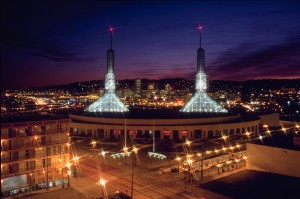 This morning’s Oregonian headlined the news that Mayor Sam Adams and his partners-in-sports have backtracked and won’t take the wrecking ball to Memorial Coliseum, after all.
This morning’s Oregonian headlined the news that Mayor Sam Adams and his partners-in-sports have backtracked and won’t take the wrecking ball to Memorial Coliseum, after all.
Hooray for that. But the story’s far from over.
Mark Larabee’s report says that aspiring mogul Merritt Paulson will shift his proposed minor-league baseball stadium back to the Lents neighborhood of Southeast Portland instead of trying to squeeze it into the Rose Quarter site controlled by full-fledged mogul Paul Allen, whose Trail Blazers organization wants to redevelop the whole shooting match for a highly questionable, theme-park-ish entertainment district. Fellow scatterer Barry Johnson, over at his alternate-universe blog on OregonLive.com, raises several pertinent red flags. Read his column — it’s important.
Questions:
1. Why build a 9,000-seat minor-league baseball park at all? Lents might want it, and maybe it’ll be good for a neighborhood that could use a few good things, and certainly it’ll provide some decent (if short-term) construction jobs. But is it necessary? PGE Park, which is now slated to become a soccer-only stadium for Paulson’s new major-league soccer franchise, is still a great place to see a baseball game. We’re told the soccer league insists that member teams provide soccer-only stadiums, but let’s face it: “Major” league or not, we’re not talking baseball or football or the NBA or even big-league hockey here. Why not call the league’s bluff? After all, we’re all paying for this thing. It’s in the public’s best interest to (a) insist on the best deal possible, and (b) decide whether it wants to make a deal at all. Sam doesn’t get to decide that all by himself.
2. Why should the Blazers decide what the best use of Memorial Coliseum will be? Yes, I know the city cut Allen and his companies a sweetheart deal on management of the Coliseum and the rest of the district, which is part of the reason the Coliseum’s become run-down: The Blazers don’t have a lot of incentive to let it compete seriously with their own Rose Garden. Time for the city to rethink this thing and stand up for itself. The Coliseum needs to be reimagined as an attractor for the entire city, not just a money-maker for the Allen organizations. I still very much like the idea of a first-class participatory sports and recreation center. That would draw thousands of people into the Rose Quarter, year-round.
3. Why are Randy Leonard’s heels dug in? The famously assertive city commissioner, who has been Adams’ sidekick through this thing, says that with the Rose Quarter off the table for the baseball stadium, he won’t consider any option other than Lents for the new ballpark. “It’s either Lents or I’m off the deal entirely,” Larabee quotes him. Wait a minute: What about leaving the Triple-A Beavers at PGE Park, where they could easily be scheduled around the new big-league soccer team and would — hello — help keep the stadium from sitting idle most of the year? Our city council isn’t prepared to even consider that? This is the cheapest option. It might also be the best.
4. What about big-league baseball? We’re talking $55 million for a 9,000-seat minor-league baseball park when (a) most Portlanders simply don’t care about minor-league baseball, and (b) there’s an even chance that in the next five to ten years the city could lure an actual big-league franchise? Then what? How much more will the city pay for a big-league stadium? Where will the stadium be? And what will happen with the little Lents park? Maybe we should just sit out this whole Triple-A deal and work on the real thing.
5. Can someone please explain how the Hooters at the city’s northern gateway is an improvement on the old Waddle’s restaurant it replaced? At least Waddle’s had a decent corned-beef hash. This may seem like a digression, but it’s not, really, because it echoes the main trouble with the Blazers’ proposed entertainment district: It substitutes tired, watered-down (if also pumped-up) cookie-cutter ideas about culture for the local, truly individual, real deal. To borrow a line from Nancy Reagan, maybe it’s time to Just Say No.

